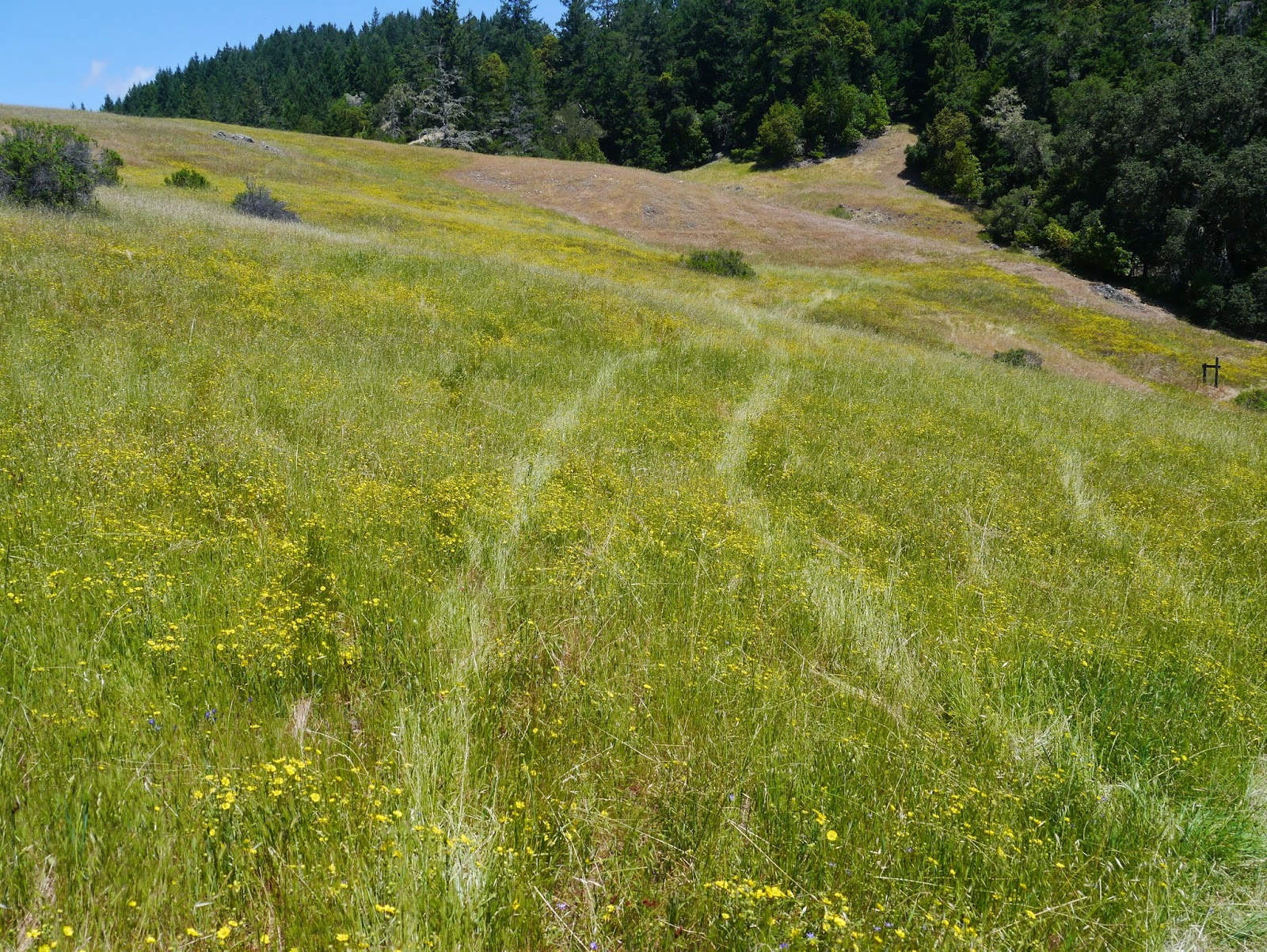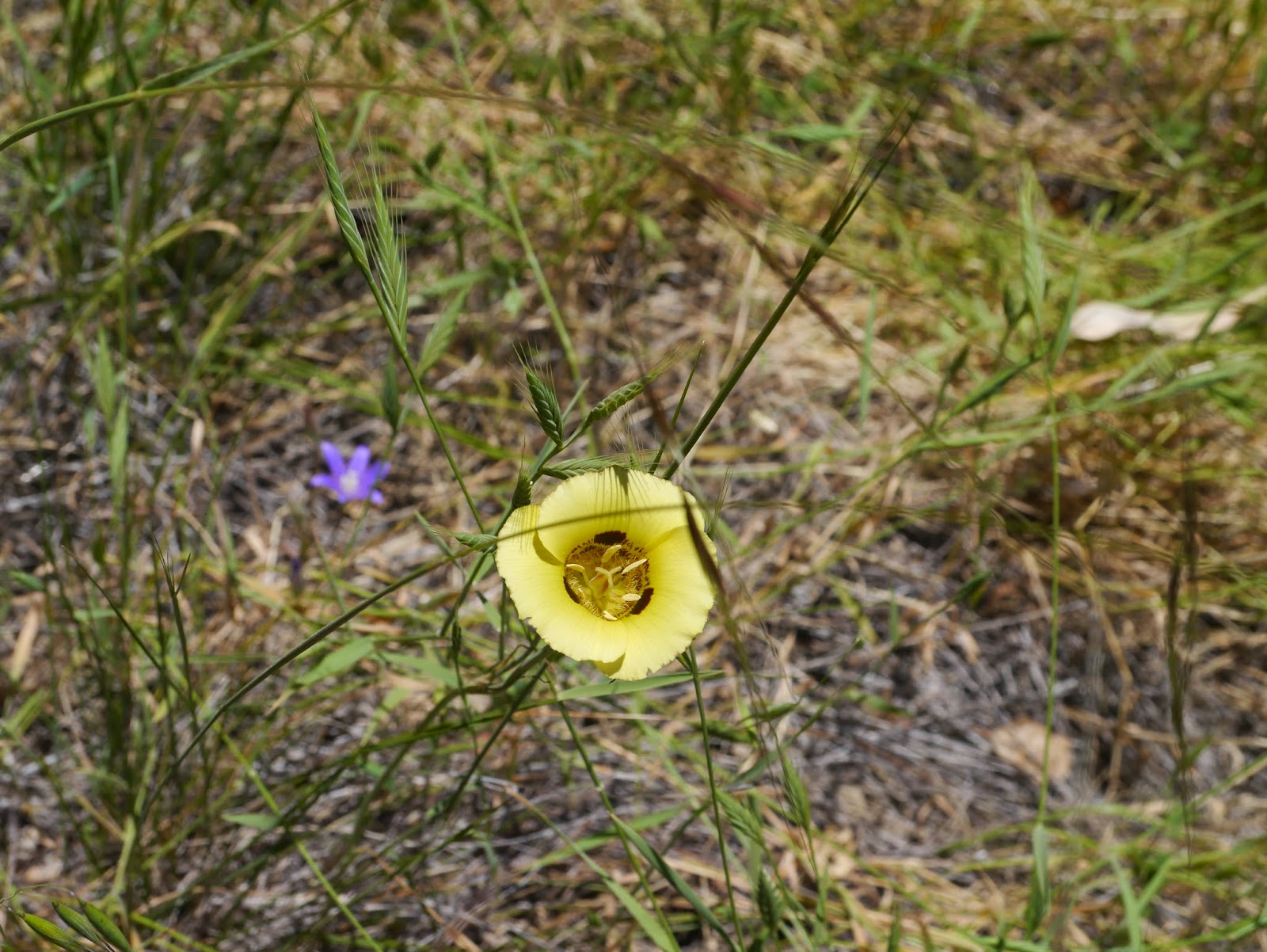At Abbott's Lagoon, on the edge of the Point Reyes Peninsula, the brush rabbits are growing up. In a single walk west to the ocean, four showed themselves along the path, decreasing in size as if moving backward through time. The fourth rabbit was positively tiny; the span of her tracks would have fit in my cupped palm. Each had a quick and perfect getaway in the salmonberry or lupine or coyotebrush thickets; they used well-kept tunnels as beloved as human footpaths, carefully maintained by tooth and claw.
The California bumblebees were out with heavy pollen baskets at their legs, tipping and delightedly dancing through the poppies, the pollen at their legs precisely the color of the heart of a poppy. I love that we call this little polished cavity ringed with fur on the back legs of bees a basket. In technical terms it is a corbicula, but that word means nothing to me, whereas pollen-basket, metaphoric, animate, immediately turns the worker-bees into beings whose devoted gathering I can comprehend with my heart. Pollen-basket is an embodied term; it places our own bodies in sisterhood with the bodies of bees, for we all know the delight of gathering food into a basket—and oh, can you imagine, if you were so small it could be pollen?
In the past week, I've read the second half of Robert MacFarlane's The Old Ways, and the entirety of Jay Griffiths' Wild. Both were utterly, beautifully brilliant—in ways that bled right into each other, so that as I read Wild, and felt inspirations and ideas stirring, I sometimes wasn't sure from which book they had come, and also in their own very unique, very different fashions. The Old Ways stirred me up into a foot-loose fever of walking-joy, my imagination spinning with songlines and pathways and the stories we pass through as we walk, the way a landscape stories us. Wild broke my heart into a dozen pieces and re-stitched it into a patchwork of nettle leaves and bee-pollen baskets, fertile brush rabbit-love and salmonberry petals and also rage; rage that our way of life has set the great wildness of the world, our salvation, our mother, our holy fool, under the direst of attacks. This is an old rage, smoldering somewhere deep but Wild set it to flaming again.
"The library of Miguel Angel Blanco is no ordinary library. It is not arranged according to topic and subject, nor is it navigated by means of the Dewey Decimal system. Its full name is the Library of the Forest, La Biblioteca del Bosque. It has so far been a quarter of a century in the making, and at last count it consisted of more than 1,100 books—though its books are not only books, but also reliquaries. Each book contains a journey made by walking, and each contains the natural objects and substances gathered along that particular path: seaweed, snakeskin, mica flakes, crystals of quartz, sea beans, lightning-scorched pine timber, the wing of a grey partridge, pillows of moss, worked flint, cubes of pyrite, pollen, resin, acorn cups, the leaves of holm oak, beech, elm. Over the many years of its making, the library has increased in volume and spread in space. It now occupies the entire ground floor and basement of an apartment building in the north of Madrid. Entering the rooms in which it exists feels like stepping into the pages of a Jorge Luis Borges story: 'The Library of Babel' crossed with 'The Garden of Forking Paths,' perhaps" (239).
What's more, Miguel makes his visitors, including MacFarlane, draw books from the shelves as one might draw tarot cards—for the past, for the present, for the future, the walks and the constellation of earthen beings along the way taking on a sort of divinatory power. Naturally, I love this.
My ramble to Abbott's Lagoon (with my wonderful twelve-year-old poetry student!) has gathered in the lines of its pages & paths: the poppy-pollen baskets of bumble bees; salmonberries from flower to fruit; four baby brush rabbits; a hunting northern harrier hawk swooping like cut pieces of moon; the sheep sorrel red against the yarrow white; the cattails at the edge of the lagoon full of marsh wrens singing their raucous love songs; the damselflies mating, their color the only word capable of describing that blue lagoon.
Imagine, what it would mean to weekly mark and map rambles through land not in path and topographical features, but the way your body, heart and mind hitch to the plants and animals around you as you walk—for a whole year! Imagine, atlases of place made thus by each of us, and the Strange Library they would together create! Maybe not navigationally useful for others, but for all the inner mapping, and the place where self and wild land meet--oh yes, oh yes indeed.
These maps become circular, like baskets (have become obsessed with twining whatever I can get my hands on--oatgrass below), that lead us out and in at once, making our own songlines of place until it has seeped, singing, right up our soles.
The second Songline Map I have to share comes from another beach, just north of Abbott's, called Kehoe, where my love and I ambled some four days later.
The path was yellow with lupine and wild radish and afternoon sun.
Sand holds the tracks of humans and animals alike. It is a great book of trails and wild tales, where Simon and I have rambled together so many times, where the coyotes hunt the brush rabbits and the ravens criss cross along the sand for carrion and who knows what other mysterious purposes.

As you all know by now, I have a particular love of, and delight in, animal tracking, in the sense of story-trailing and shape-shifting it imparts, as well as the true and particular wonder that comes of devoting all of your senses for a time to the animals who are living their lives within a place. Not just any coyote, but a Coyote and her fledgling pups nosing the dunes for baby rabbits. Not just any raven but a family of Ravens who scout the beach in a particular order every day for food, and know these sands and winds better than you or I could ever dream.
Tracking is a form of storytelling and the deepest kind of reading. Each line of coyote tracks the songline of moment in a life. As Robert MacFarlane writes, "The relationship between thinking and walking is also grained deep into language history, illuminated by perhaps the most wonderful etymology I know. The trail begins with our verb to learn, meaning 'to acquire knowledge.' Moving backwards in language time, we reach the Old English leornain, 'to get knowledge, to be cultivated.' From leornian the path leads further back, into the fricative thickets of Proto-Germanic, and to the word liznojan, which has a base sense of 'to follow or to find a track' (from the Proto-Indo-European prefix leis-, meaning 'track'). 'To learn' therefore means at root—at route—'to follow a track' " (The Old Ways, 31).
Now what could be better news than that?

"Wildness is the universal songline, sung in green gold, which we recognize the moment we hear it. What is wild is what drives the honeysuckle, what wills the dragonfly, shoves the wind and compels the poem" (Wild, 85).
For this ramble's Wild Songline, my map became the constellation of the speckled harbor seal pelt, at its center a woven vortex of eelgrass and dunegrass, whiskered like the crescent moon whiskers still attached to a dead seal's nose where we found it in the tide. Each set of whiskers is a pathway pointing to a different star in the constellation of the walk. For after all, an amble on the beach hardly ever follows a path, but rather is a back and forth up to dune and down to tideline, over to strange-shaped buoy and up to a new dune for a new cup of tea.
At the top of the Map (North) is a single blue whisker. The whisker of a harbor seal is as good at tracking fish as the echolocation of dolphins; it is a holy tracking-wand, capable of sensing the most minute changes in water pressure, current and movement. Each whisker "learning" the stories of the water as the seal swins.
It is harbor seal pupping season (March 1st through June 30th), and this beautiful seal, her pelt so lovely and intact I couldn't help but shiver and think of selkies, seemed small, perhaps a young one who didn't make it through her first spring, or maybe a small mother-seal.

Bulrush tules clacked in the wind on the walk past the marsh to the beach (West). A marbled godwit lay in the tideline, legs and neck and beak so delicate, her soul gone to the land of all shorebirds (East).

Tiny trails of brush rabbits hopped everywhere through the dunes, and were often bisected with coyote trails—the wheel of life wheeling on (South).
And speaking of weaving, of strings and strands coming together to create something, I've at last finished the knitting and sewing together of a coat I've been making for quite a long while. It is lanolin-rich Jacob sheep's wool, and a simple hardy pattern; a coat I've been longing for on walks and scrambles, beach-roams (for it is often brisk and windy on the coast here!), nights by campfires and under stars. For, at their best, the things we wear against our bodies can be magic, can be talismans, can be precious protection and invigoration on all the roads we walk, themselves stranded with the moons we pass under, the marsh wrens we stop to listen to, the harbor seal-skins we meet.
I've been known to have special "Adventuring-Skirts" worn to rags (and stained with mud, berry, avocado), particular airplane-outfits for good luck worn until they are so patchworked the security folk almost invariably pull me aside. Cloth holds story, same as good walking shoes; we only have to let the stories live there, in the weave. I am so happy to have a Wandering Coat now. It already smells of the smoke from one fire, the ocean wind and sand from one day, the marsh breeze and red-winged blackbird cries of another. Each fiber a pathway.
As Jay Griffiths writes, "The lure of wild and nomadic freedom has never left us, any of us. It is in our lungs, breathing in freedom, in our eyes, hungry for horizons, and in our feet, itching for the open road. Put your boots on. Old boots are thought to bring good luck, but old boots are good luck of themselves, as all walkers know. Boots that have folded and softened and bent to your foot: boot and foot in a cosy, comfortable marriage. (Old boots were traditionally tied to the wedding car of newlyweds, to suggest that on the long walk of life, it's good to have that easy familiar necessity.) Boots keep their history, but even more so do the feet of nomads, skin cracked like claypans in the deserts, journeys ground into the soles, feet cross-hatched with the tracks they have followed on the ground; the land has written itself into people's feet as the feet in turn have written pathways and tracks on the land" (Wild, 257).
With good coat, good boots, good hat, we trod laughing on, following Foolish maps made of marsh wren-song, harbor-seal whisker, salmonberry juice.





















































